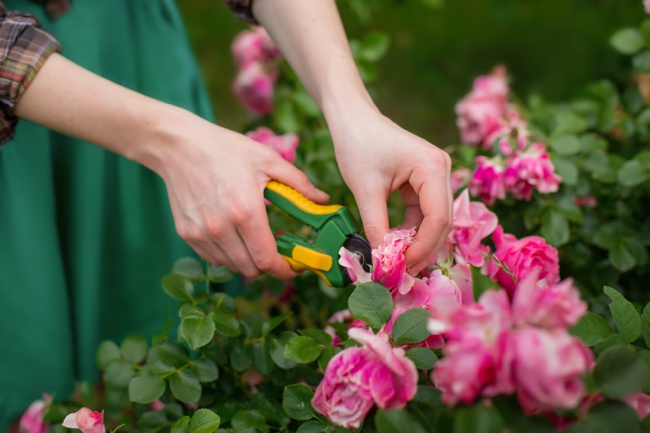I’ve been eyeing up more rose varieties to plant in my dream garden, and I came across a typical problem that knockout roses have – why are my knockout roses leggy?!
Knockout roses may become leggy due to lack of sunlight, overwatering, and poor pruning. A knockout rose needs around 6-8 hours sunlight a day to thrive, or it can become spindly and have that ‘leggy’ appearance. Other reasons for spindly growth on your knockout roses might include:
- lack of air
- overwatering or underwatering
- underfeeding or overfeeding
- improper or bad pruning
Your rose is leggy if it resembles a tiny tree more than a rose. A leggy knockout rose has stems which are unusually stretched out, flowers that are not appearing on the lower canes, or entire blooms which are flopping onto the floor. A healthy knockout rose is supposed to be a sturdy, round bush. The blooms are supposed to gently lay onto the foliage, instead of growing away from it on thin, rogue canes or spilling away from the bush.
The cure for leggy knockout roses is check the amount of available sunshine. Eure your rose is getting at least six hours of direct sunlight a day. Plant it in a spot where sunlight is direct, to eliminate your rose’s need to stretch out and up to reach light. To prevent leggy roses, ensure you are watering your knockout rose once to twice a week. Finally, a good pruning can fix most leggy knockout roses. If your knockout rose is already leggy, prune it back about one third of the overall growth, removing all the dead, diseased and dried canes, mostly from the top area of your rose bush, and use pruners that are double sided to ensure a neater cut. Prune right back until you can see the center (white) of the cane.
Proper watering, pruning and enough sunlight for your rose bush will ensure it grows bushy and thick, rather than leggy, tall, and spindly!
Table of Contents
What is a healthy knockout rose supposed to look like?
Healthy knockout roses are bright red or bright pink. They form round bushy forms and tend to stay low. They will not usually grow over 4 feet in height. A healthy knockout rose bush should keep the round bushy form on its own, and not need a lot (if any) pruning on your behalf.
Most importantly, healthy knockout roses should have blooms which are abundant, smell intensely fruity, and sit directly on the bushy growth. This means that the blooms itself are not supposed to grow tall, or straw far away into the height from the bush form of the plant. Even if your knockout rose is a small plant which is only starting to form its bushy form, blooms will tend to lie close to the foliage.
How do I know if my knockout rose is leggy?
Leggy knockout roses do not produce any blooms on the lower canes. In knockout roses, this particularly manifests with the blooms sticking out like a sore thumb, high up from the main bushy growth.
In general, spindly roses take on an appearance of a tree in a miniature, looking more like a knockoff bonsai tree than anything like a rose. If you suspect that your knockout rose is too elongated, the flowers are weaker or don’t appear on lower canes, the flowers seem to be tipping over towards the floor and sagging – you have a leggy knockout rose on your hands.
What is the main cause of leggy knockout roses?
The main cause of leggy knockout roses is most often a lack of sunlight. However, if you’re sure your rose is getting six hours of sunlight and over, there might be other underlying issues causing spindly growth. Some of the most common issues afflicting leggy knockout roses are:
- poor circulation between knockout roses and other plants
- lack of sunlight
- lack of air
- inadequate or no pruning
- pre-existing damage in rose canes
- black spot disease
- underwatering or overwatering
- underfeeding or overfeeding
How to prevent knockout roses from becoming leggy
Since one of the main reasons for knockout roses becoming leggy is not enough sunlight reaching the centre of the rose, the first thing to do is check if your rose is getting enough sunlight. Your rose will need between 6-8 hours sunlight per day. As tedious as it may seem, deficiencies in basic rose care usually cause spindly growth!
Provide the roses with enough sunlight
Knockout roses most commonly become leggy trying to stretch out towards a light source. Plant stretching will occur when there is little natural or artificial light for the plant to use. The plant strains in order to get the tiniest amount available to fuel photosynthesis and flowering. Planting your rose at a spot that gets six to seven hours of direct daily sunlight will eliminate this issue at the core!
Space your roses out
Poor circulation is another reason why knockout roses become leggy. When planting or transplanting, make sure your knockout roses have room to breathe. It’s fine to plant roses to give them a little bit of overlap, but with shrub roses, don’t allow a full merge to occur. A lack of air is one of the leading reasons behind the formation of spindly knockout roses. Make sure you space two bushes at least 20 to 30 cm apart in your garden.
Prune your roses in early spring
Another good trick to prevent knockout roses from becoming leggy is to prune early in the spring. After the first frosts have passed, in early April, give your knockout rose a light pruning. The growth that comes to grow into the warm weather will be stronger and sturdier, a stark contrast to spindly growth.
Feed your roses well
Finally, feed your knockout roses regularly, at least every three weeks throughout the season. In order to stave off spindly growth, make sure that the fertiliser isn’t high in nitrogen, as high nitrogen in fertilisers causes legginess in knockout roses. Use organic fertilisers, such as rice water or coffee grounds!
How to prune leggy knockout roses
Pruning is incredibly important to keep roses from becoming leggy, and it isn’t too difficult, either! While knockout roses are usually self-cleaning, if they get leggy, prune them away to regain a healthy form.
Arm yourself with a pair of sharp, disinfected secateurs! Hand pruners are the easiest to use in order to deal with spindly rose growth. The clean cuts will aid in healing the rose, instead of dealing more damage with improper cuts. Remember to put your gloves on!
It is best to prune an already leggy rose whenever the rose is dormant. This is usually late in winter, January/February or June/July depending on the hemisphere. Follow the golden rule – diseased, dying, damaged and dry stems need to go first. Additionally, cut any brown or black stems fully. Snip away until you get rid of all of these canes. Make sure to disinfect the secateurs if you suspect a disease might be afoot among your knockouts.
How far back can I cut back my knockout roses?
Knockout roses are shrub roses, and as such, the general rule is that you can remove one third of its entire growth without fear. Anything more than that risks the knockout rose not making it through the winter.
After pruning your knockout roses, make sure to physically open up your shrub. Gently rearrange the stems to form a cup-like shape. This will allow breathability within the shrub and prevent fungal diseases from afflicting the plant.
How often should I water my knockout roses?
While knockout roses are fairly low maintenance, they still need a regular splash of water twice a week. Generally, knockouts prefer a consistently moist soil better than being watered often. Make sure to water your rose from the base. The water should go straight to the soil, instead of over the blooms or the foliage. As knockout roses are shrub roses, getting the foliage wet spells disaster during colder months, potentially leading to fungal disease.
Keep a habit of checking the topsoil every other day. If you find the first 2.5 cm too dry, add more water. Developing this habit helps with keeping track of your rose’s needs during the summer months, when they might need to be watered daily. If you grow your knockout roses in pots, consider that they will need watering up to four times a week in order to meet their needs.
How often should I feed my knockout roses?
Just like any other shrubby rose, knockout roses should be fed throughout the season, every three to four weeks. Knockout roses really do not ask for a lot. However, if you want to keep them from becoming spindly, skip out on the high nitrogen fertilisers!
Start fertilising knockout roses in April, which is around the time that the last frosts have passed. Continue this practice every three to four weeks and discontinue in the last weeks of August, or six weeks before the first frosts are expected to begin. In order to ensure that you’re not overfeeding your knockout roses, skip out on the store-bought fertiliser and go organic. Rice water is a mild organic fertiliser which is simple to prepare at home and suitable for knockout roses, giving them a boost in blooms while preventing them from flopping and growing too tall.
These steps will help you to fix your leggy knockout roses!





